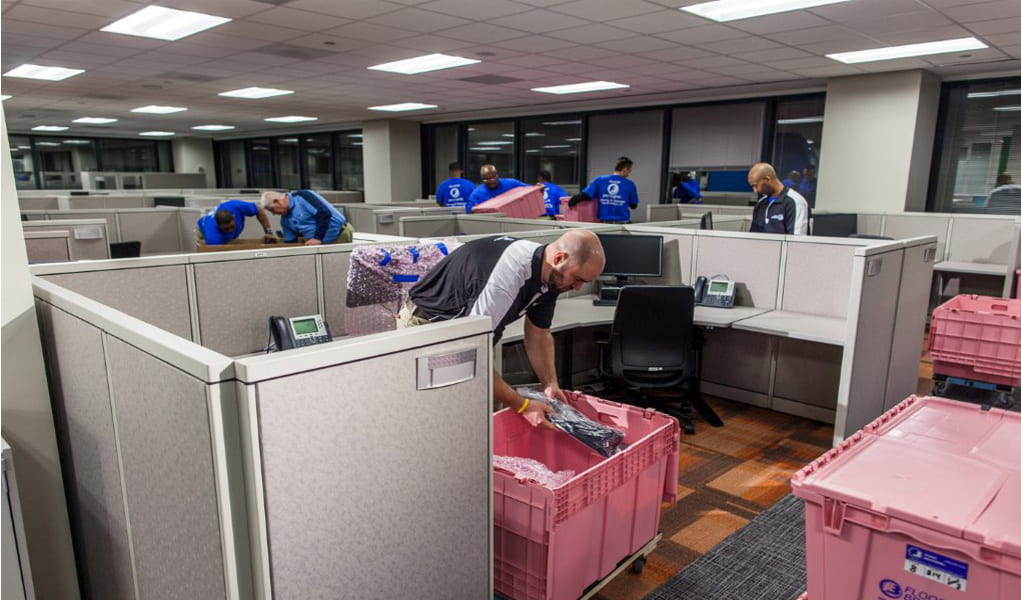The decision to relocate a company involves a number of variables that need to be carefully analyzed for the process to be successful, obtaining additional benefits in terms of operating cost reduction, space optimization and a substantial improvement in culture, organizational climate and productivity.
1) How many space are needed?

A very common mistake made by executives in charge of a corporate move is to estimate the amount of space needed in the new office according to the square meters of the current one. Calculations such as: if we have 20% more employees, ergo we need 20% more space, are usually a bad criterion for making estimates.
It must be taken into account that each office floor has different yields according to its geometry, number of columns, modulation, installations and window perimeter, among other variables. In short, each square meter can be much more profitable in one alternative than in another, without sacrificing comfort.
Any professional specialized in the subject will be able to estimate, with the program of needs and according to the usual ratios, the theoretical size of the new office to focus the real estate search. When you have a pre-selection of possible locations, it is highly recommended to carry out a test fit study in each one of them. You will be surprised at the differences.
The new workspace should be useful for several years, so don’t forget to incorporate the growth variable into the square footage estimate.
2) Where to move to?
The location of the new office is a very sensitive issue and often decided by unclear or too subjective criteria.
It is very simple to make an evaluation matrix incorporating the important criteria of the company when deciding the location. The most usual variables are: the location of the clients, the place where the employees live, the location of the suppliers, the services available in the area, means of transportation, etc. As for the building, it is important to consider the number of parking spaces, the security of the area and the image it will bring to the company.
When evaluating the price, do not forget to include operating and maintenance costs in the equation, since some sale or rental prices seem more attractive than they really are.

3) Now or never
The change of office is the ideal moment to incorporate changes in the uses and customs in the organization. Don’t miss the opportunity to rethink the way the company works and incorporate these new criteria into the conceptualization of the workspace.
4) Who leads the process?

The decision to relocate a corporate office is defined at the highest hierarchical levels of an organization, but from an operational point of view it normally falls on a middle management official.
Because of the expectation that moves create in the company’s staff, this process is highly exposed and generates many pressures and conflicts of interest.
That’s why at Flood Brothers we specialize in commercial moving with highly efficient equipment. Our experienced and highly specialized team can assist you in this critical process.
5) How much does it cost to move a company?
The main concern for companies facing a move is how to quantify in advance the amount of money that will be involved in the whole process. Knowing in advance the amount to be invested is fundamental for companies, since they work with assigned budgets and this value is essential information when making a decision to move or remodel, where large sums of money are involved.
It has been proven that an exhaustive strategic planning, from the moment of the search for the new property to the final move (including the architectural project, the work and the equipment) allows an accurate evaluation and avoids the occurrence of unexpected expenses. In this way, the best decisions can be made at an early stage, optimizing resources, reducing unnecessary expenses and minimizing imponderables.
If you intend to carry out the work by separate contract management (project, furniture, wiring, ceilings, carpet, etc.) it is advisable to hire a company that provides the Project Management service with a Guaranteed Maximum Price contract. Another alternative is a turnkey project, where the final value of the work is guaranteed before starting.
Do not forget some expenses that are usually left out of the list, such as moving costs, connectivity, new stationery, accessories and household goods, inauguration event and communication to clients and suppliers, among others.
6) How long does a commercial move take?
Another fundamental factor for a company involved in a move is to be able to anticipate with certainty the total time the process will take and the precise date of the move. Being assertive with this information will allow the company to adequately plan the stages of the move, thus avoiding losses in productivity.
The logistics of the move has many variables to consider: date of completion of the work, transfers, connectivity, packing, etc. It follows then that it would be very inconvenient, and sometimes even unfeasible, to be changing the day of the move. It is therefore essential to have a track record of compliance with the deadlines of the company hired to carry out this process, since the fines in the contracts, no matter how high they may be, do not ensure compliance with the deadlines.
When planning the chronogram, do not forget the time required for the signing of contracts for leasing, construction and professional services.
Make sure that your own administration is capable of processing the committed payments in due time and form, since this is a singular event and the company’s organization is designed to be efficient in its core business and not necessarily to efficiently attend a process that occurs once every several years.
If you took a deviation margin in the schedule, keep it confidential, since when you disclose it, it will automatically become the new official date.
7) Use of space
The work environment is in flux. Technology, high competition, the global economy and the arrival of new generations in the world of work are radically changing the way we work. Mobility, flexibility, employee knowledge and environmental friendliness are the new forces that will shape the new office.
The workspace takes on a new meaning in the era of mobile workers, turning the office into a place of interaction and collaboration much more than individual work – which today can be done at any time and, above all, from anywhere.
Do not allocate square meters according to hierarchies, but according to your real need. A senior manager, who is supposed to have an office with more space, will occupy very little of those assigned meters, since most of the day is spent in meetings in and out of the office or traveling.
Increase the number and type of spaces for collaborative work and employee interaction. Multifunctional, comfortable, stimulating and attractive spaces that generate a good working environment, increase productivity, the sense of belonging and encourage creativity.
Therefore, a very careful analysis of the type of activity to be developed, the work flow, the corporate image and the profile of the collaborators is necessary to define the optimal way in which the work environment will be modeled.
8) Efficient communication
Like any major change, moving an organization is a high-impact and highly sensitive process for the work team. The challenge is to achieve a successful relocation without affecting the company’s productivity and internal climate.
Schedule an efficient communication of the project that focuses on the reasons and benefits of the change, the characteristics of the new space and the new area, and anticipate the key moments of the process and involve the natural leaders in the process.
In this way, you will be able to minimize anxieties, reduce internal conflicts and generate a positive current that favors the change process.
9) The move in the hands of experts
Once the new office has been designed and built, it is time to move. This instance is much more than the simple physical act of carrying packages from one place to another. It involves designing a plan in stages that prevents the company from losing operations, rigorously coordinating the storage of documentation, the transfer of equipment and the start-up of servers and technical equipment.
Again, only a properly planned strategic plan and a good supplier will ensure success in this decisive instance. Ensuring that nothing is lost or damaged along the way and that on the first day in the new office, everything is in place and ready for use.
10) And, after the move… what happens?
Once the company is installed in the new office, a series of needs begin to arise: forgetfulness, new requirements, adaptations, adjustments to installations, touching up paintwork damaged during the move, etc.
The team of professionals and contractors that were working on the construction site arrives exhausted at this stage and is not usually more willing to take care of these issues, since they are minor jobs, of small amounts and that require an immediate response. To meet these needs, then, it is advisable that a new team be in charge of carrying out the tasks at this stage. Ideally, this new team should be incorporated into the process some time in advance so that it is familiar with the project, the work and the installations and can provide solutions in accordance with the concept of the proposed space. The best solution is for the contracted company to have an area for this purpose; otherwise, the alternative would be to involve in this stage the team that will be in charge of the maintenance and operation of the workspace during the useful life of the office.


